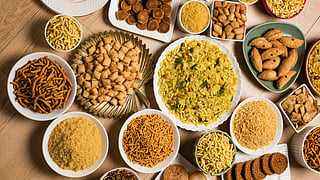- HOMEGROWN WORLD
- #HGCREATORS
- #HGEXPLORE
- #HGVOICES
- #HGSHOP
- CAREERS
- ABOUT US
- CONTACT US

One of the best things about Diwali apart from the firecrackers of course, are the snacks. A Diwali dinner might be a one-night feast but the array of savoury and sweet snacks that families across the country prepare for the festival lasts for weeks. There's also the ritual of sharing the 'Diwali plate' with your neighbours the morning after; something that I was tasked with a lot in my childhood. In Maharashtra, the little gift plate with sweet and savoury delights is known as 'faral'.
This festive exchange taught me about how each snack had a different taste and story based on the cultural roots of a family. Which is also why most Diwali snacks are popular across India, despite their local origins like the same Murukku in South India becomes Chakri in Gujarat. The slight difference in flavours and ingredients however distinguish which part of India every Diwali staple comes from. And we've made you a list that tells you just that.
Murukku, which means 'twisted' in Tamil, is a crunchy, savory snack from South India made by deep-frying a dough of rice flour, urad dal flour, salt, and oil until it turns golden brown. Known for its long, coiled shape, murukku is super popular in places like Tamil Nadu, Karnataka, Kerala, and Andhra Pradesh. In other states this is also called chakli. Some Murukkus have sesame seeds in their recipe that gives them an extra nutty flavour. But a good Murukku is mostly identified by how brittle it is; neither crumbly, now jaw-breaking, with just the right amount of crunch. Check out a recipe of it below.
Shankarpali is a diamond-shaped, crispy snack from Maharashtra, often enjoyed during Diwali. This semi-sweet treat is made by deep-frying dough mixed with flour, semolina, sugar, and ghee until it’s golden and crunchy. Known by different names like shakkarpara, murali, khurma, and lakdi mithai, it’s a favorite across India. The name actually comes from the Persian word 'Shekarpareh'. We all know how Diwali can get a little too sweet with the sheer number of mithais we have as a culture. Shankarpali then becomes a comfort snack to balance the palate. Those who are a sucker for 'not too sweet' treat will know what I mean. Find the recipe for them below.
Gujhiya or Gughara is a delicious, crescent-shaped pastry that’s super popular in India, especially around Holi and Diwali. It’s got a crispy, flaky crust with a soft, sweet filling. Made with all-purpose flour or semolina, it’s stuffed with sweetened khoa, dried fruits, nuts, and sometimes a hint of cardamom. To make it, you roll out the dough, fill it up, fold it into a crescent, and deep-fry it to a golden brown. For a step-by-step process, watch the video below.
Mathri is a crunchy, flaky snack from Rajasthan, India, made with flour, water, and spices like cumin, carom seeds, sesame seeds, and fenugreek leaves. Its dough is similar to samosa dough, usually using refined flour and semolina, and when fried just right, it has a perfect crispiness. It can be made both circular like biscuits or long like French fries. Mathri is often enjoyed with tea or pickles but can be paired with yogurt, sauces, or chutneys too. It stays fresh in an airtight container for up to a month, making it a go-to snack, especially during festivals like Diwali, Holi, Karva Chauth, and Teej. Watch hoe to make it below.
Khaja is made from a deep-fried pastry soaked in sugar syrup called paga, giving it a crispy, wafery texture that melts in your mouth. Having absorbed the syrup, the pastry still remains semi-dry which only gets better with time as the sugar crystallizes. Made with wheat flour, sugar, oil, and sometimes cardamom and ghee, it’s a treat often enjoyed during festivals and special occasions. It’s believed to have its roots in the old regions of Oudh, now part of eastern Uttar Pradesh and western Bihar.
If you enjoyed reading this, here's more from Homegrown:
Diwali In A Cone: Bono’s Gulab Jamun Ice Cream Puts A Festive Twist On A Classic Dessert
From Fogla To Shevla: 10 Traditional Foods That Are Disappearing From Indian Plates
'Kalari', A Homegrown Cheese From Jammu, Is One Of India's Best-Kept Culinary Secrets
